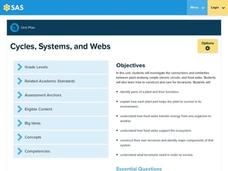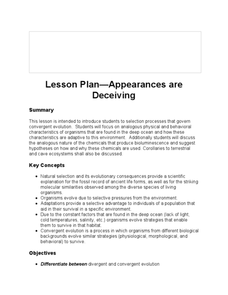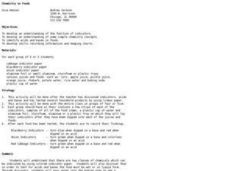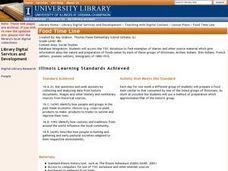Curated OER
Building a Terrarium System
Learners create their own terrariums. In this ecological model lesson, students create terrariums using soil, seeds, pebbles, and two liter bottles. Learners compare the elements of a terrarium to a food web.
Pennsylvania Department of Education
Cycles, Systems, and Webs
Fourth graders review the parts of the plant and their functions. In this plant lesson plan, 4th graders recognize that plants must transfer energy to make food. Students understand the interdependence of organisms in an ecosystem.
Curated OER
Lesson Plan - Appearances are Deceiving
Herre is a lesson on divergent and convergent evolution. It has links to terrific video clips, an associate worksheet, and more. The analysis questions have been reviewed separately on Lesson Planet if you would like more information....
Curated OER
The World in Our Food
Students explore the history of ingredients in one of the recipes they prepare in class. They examine where each ingredient is produced and under what conditions. In addition, they brainstorm alternatives that are environmentally...
Curated OER
Chemistry in Foods
Students investigate foods that are indicators, and acids and bases. In this food chemistry lesson plan, students test household products with litmus paper and with food indicators. They use blackberry, onion and red cabbage indicators...
Curated OER
Planning a Trip for Christopher Columbus
First graders plan a trip for Christopher Columbus. They use their math skills to construct a ship for Columbus' voyage. They show their ship and calculations to their classmates and build graphs to show the amount of supplies needed to...
Curated OER
Irish Potato Products
Students investigate the effects of low and high temperatures on potato products. In this potato products lesson plan, students demonstrate the effects of storage conditions on Irish potatoes. They investigate the effects of frying, they...
Curated OER
Spear Point Production
Young scholars explore that prehistoric people had to have a good knowledge of the physical world around them in order to choose the best material for spear production. They also explore that prehistoric people were intelligent beings...
Curated OER
Building a Food Pyramid
Students review the concept of the food pyramid that has been taught by the classroom teacher. They have a classroom discussion of the food pyramid; understanding the importance of a healthy diet. Students create an original food pyramid.
Curated OER
Food Group Fun
Students explore the four food groups and nutrition. They cut out pictures of food from newspapers and magazines, create placemats, and create an ABC book of food.
Curated OER
Get Your Calcium-Rich Foods
Sixth graders explore foods in the dairy group. In this dairy food lesson, 6th graders examine the nutritional value of dairy foods and determine the proper number of dairy servings per day. Students also evaluate numerous food labels of...
Curated OER
Food Time Line
Fourth graders make a timeline to include the immigrants of 1880-1910. Then, in groups, they research foods consumed, purchase, and serve it to the class.
Curated OER
Food Webs
Fourth graders discover how organisms depend upon each other in an ecosystem. In this ecosystems lesson plan, 4th graders use food webs to discuss the interdependence between organisms in an ecosystem.
Curated OER
Nutrition and the Food Pyramid
First graders examine the food pyramid and how healthy food effects the body. They discuss what they ate for breakfast and identify what makes a food healthy. Students analyze the food pyramid, and cut out magazine pictures of food and...
Curated OER
Earth: The Food We Eat, The Seeds We Sow
High schoolers explore the importance of seed diversity for cultural and ecological stability/health. They discover what an heirloom seed is and why they are important to conserve.
Curated OER
Fast Food Survey Using Bar Graphs
Second graders create a bar graph to pictorically represent the data collected from a survey of students. They use Excel to electronically create the graphs and data tallies. They then interpret their data using sentences to explain.
Baylor College
Your Nutrition Needs
It takes some work to ensure you have a balanced diet, but once you know the types of foods that are good for you, it becomes second nature. In the sixth of seven lessons about energy and nutrition, learners create a healthy eating plan...
Perkins School for the Blind
Student Store
Vocational training activities are extremely important for learners with intellectual or physical disabilities. Here is a great idea that will help your class become skilled at money handling, basic economic concepts, interpersonal...
BW Walch
Vending Machine Bans Increase in Schools Nationwide
Does a ban on vending machines infringe on student rights, or do school officials have an obligation to monitor foods sold on school grounds? Your class members will explore the educational, health, and financial issues related to...
Serendip
Photosynthesis and Cellular Respiration
How does energy from the sun make plants grow? Scholars move step by step through the processes that promote plant propagation during a detailed lesson. The resource illustrates ADP production and hydrolysis, then allows learners to...
Curated OER
Where's the Beef - Beef Facts or Hype, Is it Bad for You?
Analyze a Happy Meal™ for nutrient content and calories. Blend the contents into "McMush" and use Biuret's solution to test for protein content. There are a few problems with the lesson plan: the resource links are no longer valid, the...
Curated OER
Making Your Local Ethical Shopping Guide
Learners write a research action plan on how to buy products that are environmentally friendly even in tough world conditions. In this ethical business lesson plan, students learn that the economy, food prices, natural disasters, and...
Curated OER
Pyramid Power
Students observe human health by analyzing different food groups. In this food pyramid lesson, students utilize the web to complete an interactive food pyramid game as well as research the nutrition encyclopedia. Students discuss their...
Curated OER
You're Wearing Your Plants!
Students examine the many uses of plants and trees by looking at their clothing. They make lists of products that come from plants and trees and their uses.

























